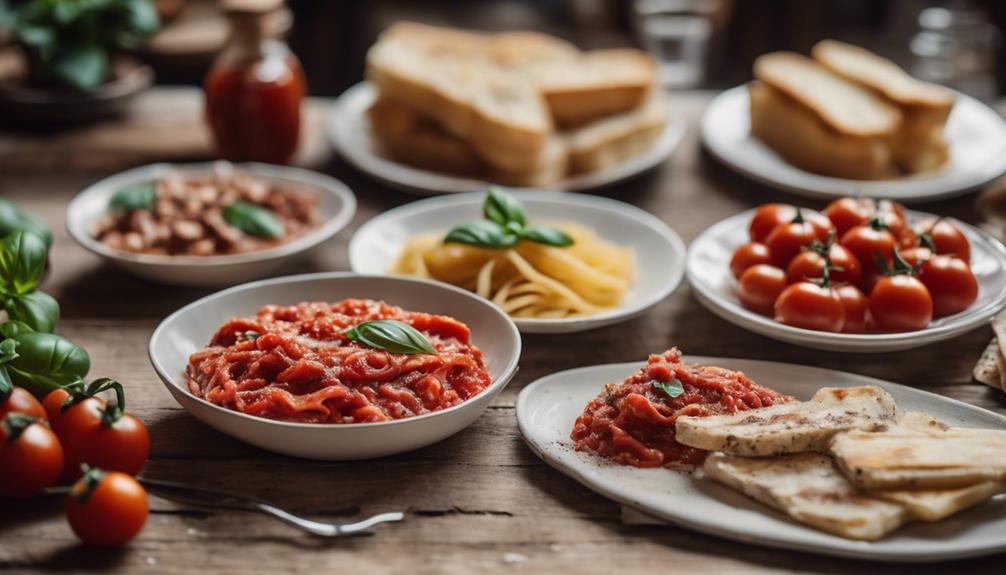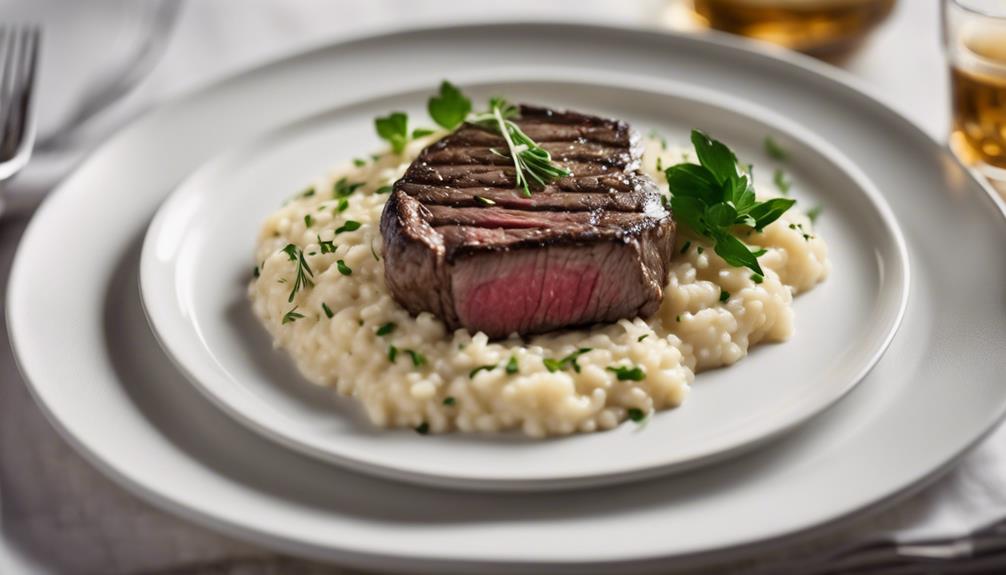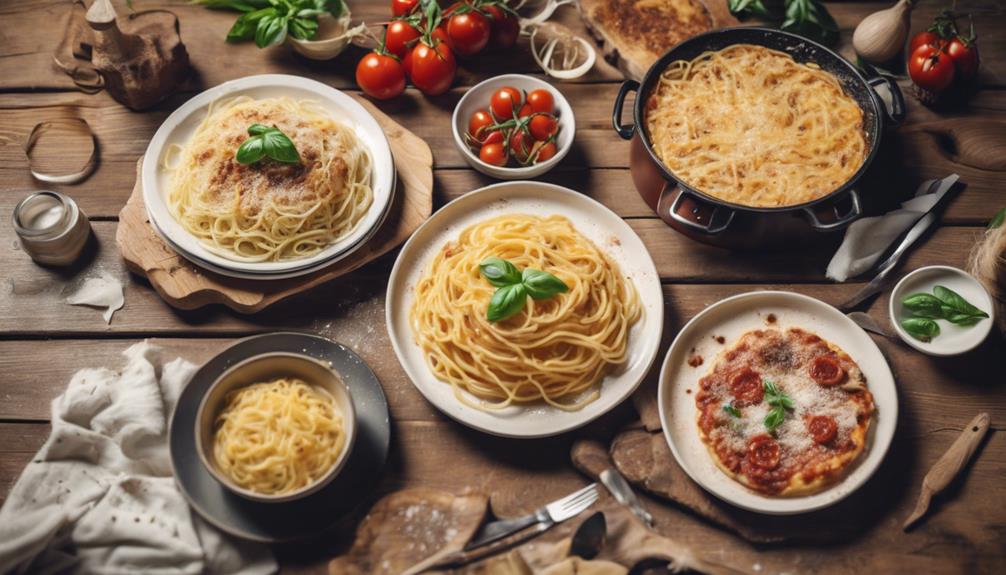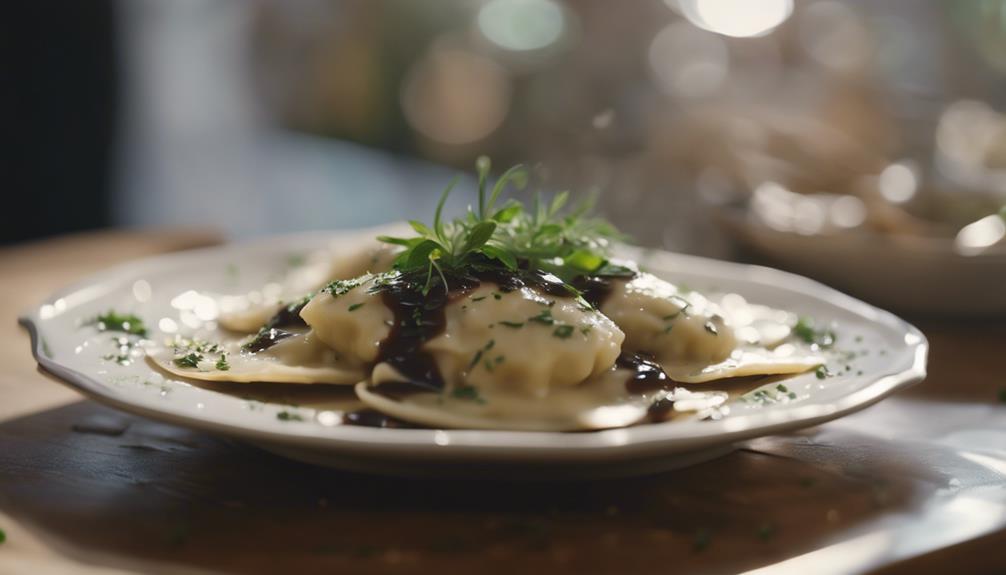When it comes to delicious Italian cuisine, prepare for a flavorful experience! From traditional dishes like Spaghetti Carbonara to hearty Osso Buco and tempting Linguine alle Vongole, Italy has something to satisfy your taste buds. Don’t forget to try the rich Tiramisu or the delectable Margherita pizza. Are you vegetarian? Indulge in dishes like Baked Eggplant with Parmesan or Puntarelle for a burst of flavor. Dive into regional specialties such as Sicily’s Pasta alla Norma for an authentic Italian experience. These dishes are just the start of a culinary journey filled with both tradition and innovation that will leave you wanting more!
Key Takeaways
- Classic Italian pasta dishes like Spaghetti Carbonara and Risotto Milanese are renowned for their rich flavors and textures.
- Traditional meat entrees such as Osso Buco and Beef Ragu showcase Italy's expertise in meat-based recipes.
- Authentic Italian seafood specialties like Linguine alle Vongole offer a taste of the Mediterranean's bounty.
- Italian vegetarian options like Baked Eggplant with Parmesan cater to those seeking meat-free alternatives.
- Regional specialties such as Sicily's Pasta alla Norma highlight the diversity and depth of Italian cuisine.
Classic Italian Pasta Dishes
When exploring classic Italian pasta dishes, you'll discover a rich tapestry of flavors and textures that define the essence of Italian cuisine. From the creamy Spaghetti Carbonara to the comforting Gnocchi with Tomato Sauce and Mozzarella, these recipes showcase the heart and soul of traditional Italian cooking. Bursting with Parmesan cheese, pancetta, and fresh herbs, these dishes offer a symphony of tastes that dance on your palate with each bite.
Italian pasta dishes are known for their simplicity yet profound flavors, emphasizing the quality of the ingredients used. Whether indulging in Pasta alla Gricia or savoring the creamy Risotto Milanese, each bite transports you to the bustling streets of Italy. The art of preparing these classics lies in the delicate balance of flavors, textures, and mastering the right cooking techniques to elevate each dish.
Traditional Italian Meat Entrees
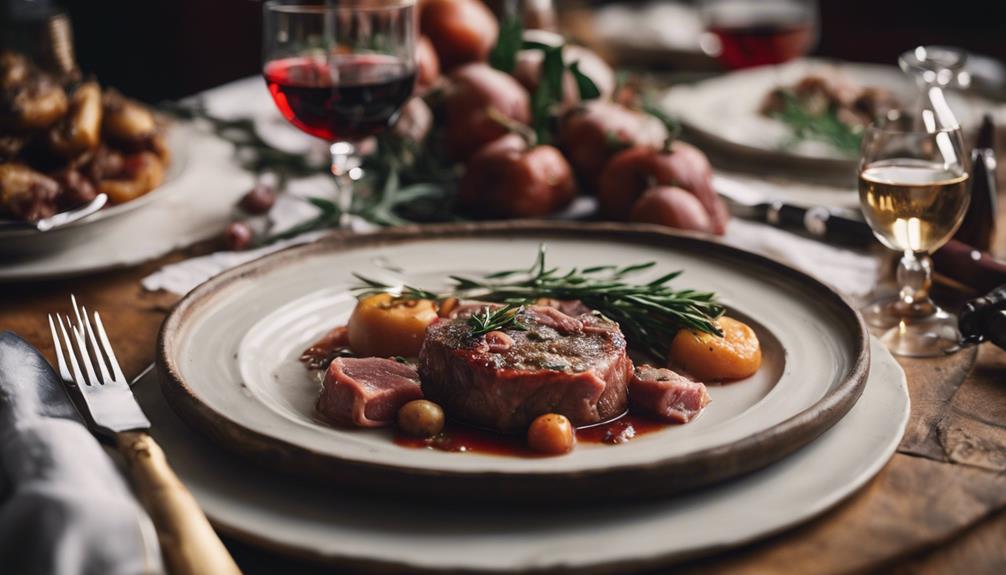
Traditional Italian Meat Entrees offer a delectable array of flavors and textures that embody the essence of Italian culinary heritage. From the rich and tender Osso Buco, a Milanese specialty of braised veal shanks, to the crispy and savory Chicken Parmesan and zesty Chicken Piccata, these dishes showcase the diverse and vibrant flavors of Italy.
Italian meatballs, a classic favorite, whether served with pasta or on their own, never fail to satisfy with their perfect blend of herbs and spices. Beef Ragu, a hearty meat sauce simmered to perfection, complements various pasta dishes exquisitely, making it a staple in Italian cuisine.
In addition to these renowned dishes, Italian comfort foods like homemade lasagna and creamy risotto also shine with their delicious meat components. The next time you crave a taste of Italy, consider indulging in one of these traditional Italian meat entrees to experience the true essence of Italian cooking at its finest.
Authentic Italian Seafood Specialties
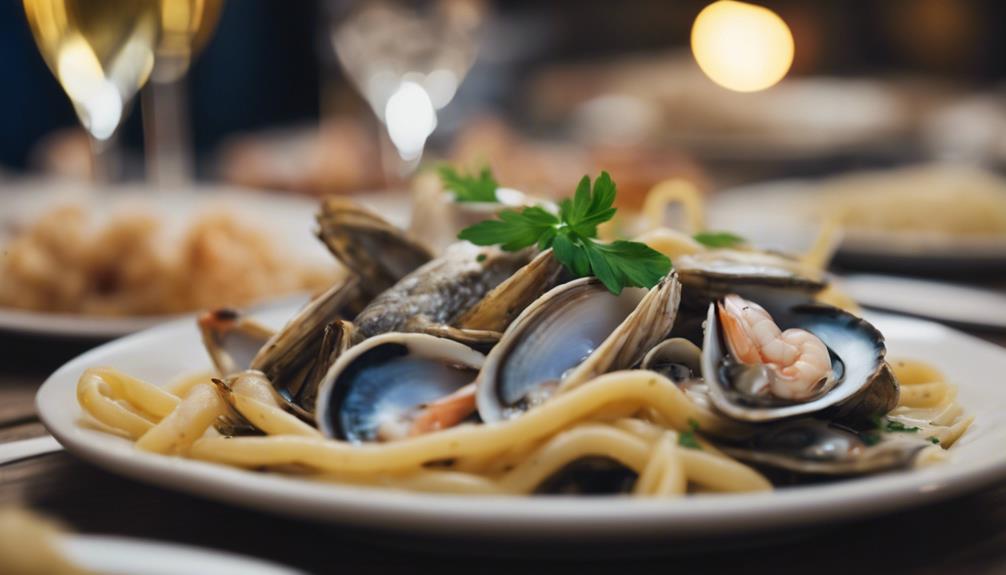
When it comes to Italian seafood specialties, get ready to indulge in a medley of flavors and textures that will transport you to the sunny shores of Italy.
From the classic Linguine alle Vongole to the delightful Fritto Misto platter, there's a seafood dish to satisfy every craving.
Let's explore the rich culinary heritage of Italy through its diverse and delicious seafood offerings.
Classic Italian Seafood Dishes
Italian cuisine boasts a variety of delectable seafood dishes that highlight the freshness and quality of ingredients like shrimp, scallops, clams, and fish. When exploring classic Italian seafood dishes, you'll find a treasure trove of flavors waiting to tantalize your taste buds.
Risotto ai Frutti di Mare combines the richness of creamy risotto with a flavorful mix of seafood, creating a dish that's both comforting and luxurious.
For pasta lovers, Linguine alle Vongole offers a taste of the sea with its savory blend of clams, garlic, white wine, and parsley, perfectly coating each strand of pasta with deliciousness.
If you're in the mood for a whole fish experience, Branzino al Cartoccio presents a visually stunning sea bass baked to perfection with a harmonious medley of herbs, lemon, and olive oil.
And let's not forget the classic Calamari Fritti, a beloved Italian appetizer featuring crispy fried squid rings served with lemon wedges – a delightful way to start any meal on a flavorful note.
Regional Seafood Variations
Explore the diverse regional seafood variations that showcase authentic Italian seafood specialties. From the northern coastal regions to the southern Mediterranean shores, Italy offers a rich tapestry of seafood dishes that celebrate the country's culinary heritage. Below is a table highlighting some of the most beloved regional seafood variations:
| Italian Seafood Specialty | Description |
|---|---|
| Linguine alle Vongole | Clams cooked with garlic, white wine, and parsley, served over linguine. |
| Risotto ai Frutti di Mare | Creamy risotto infused with an assortment of fresh seafood like shrimp, mussels, and clams. |
| Sarde in Saor | Sweet and sour sardines marinated with onions, pine nuts, and vinegar. |
| Calamari Fritti | Tender fried calamari rings served with a squeeze of lemon for a delightful crunch. |
These dishes exemplify the diversity and culinary expertise found in Italian seafood preparations, where simplicity meets bold flavors to create unforgettable dining experiences. Whether you prefer the delicate balance of Risotto ai Frutti di Mare or the crispy goodness of Calamari Fritti, Italian regional seafood variations have something to satisfy every seafood lover's palate.
Italian Vegetarian Delights
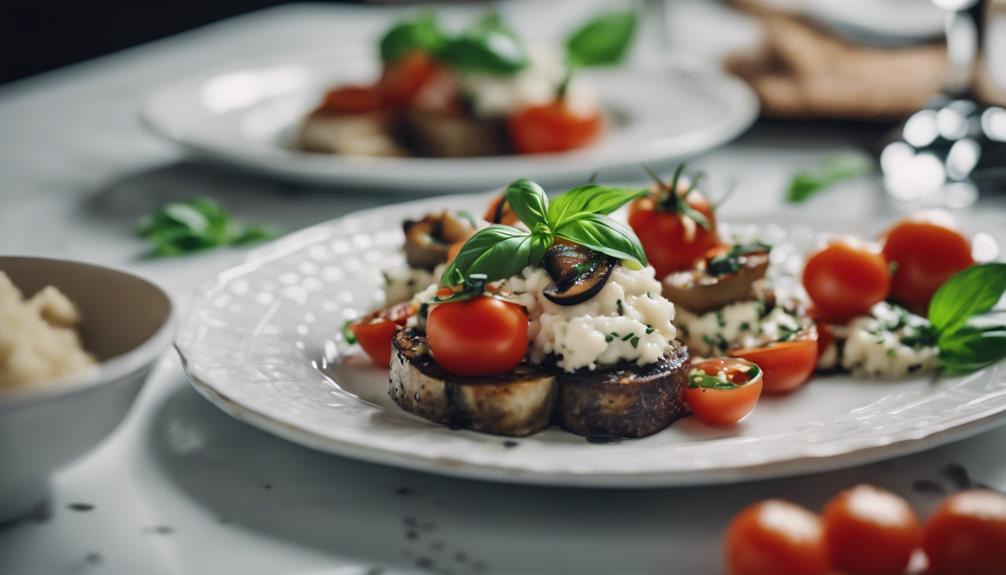
Indulge in a variety of delectable vegetarian Italian dishes that showcase the rich flavors of fresh produce and traditional seasonings. Italian cuisine offers a plethora of meat-free options that aren't only delicious but also pay homage to the country's culinary heritage.
When it comes to Italian classics, eggplant takes the spotlight in many beloved dishes. The Italian Baked Eggplant with Parmesan, featuring layers of eggplant, tomato sauce, and melted cheese, is a comforting and hearty choice for vegetarians.
For a taste of Sicily, try Caponata, a sweet and sour concoction of eggplant, tomatoes, olives, and capers that bursts with Mediterranean flavors.
If you're in the mood for a lighter option, Pomodori al Riso, Italian stuffed tomatoes filled with a flavorful rice mixture, make for a delightful and satisfying meal.
Additionally, Puntarelle, a Roman salad made with chicory and a tangy anchovy dressing, offers an invigorating and vibrant side dish.
To round off your vegetarian Italian culinary journey, savor Carciofi alla Romana, a traditional Roman artichoke dish braised to tender perfection with a blend of herbs, garlic, and white wine. These vegetarian delights are sure to please even the most discerning palates while celebrating the essence of Italian cooking.
Popular Italian Appetizers

Discover a selection of beloved appetizers in Italian cuisine that showcase the simplicity and quality of traditional ingredients. When it comes to Italian appetizers, there's a wide array of dishes that tantalize the taste buds and set the stage for a delightful meal. Here are three popular Italian appetizers that are sure to impress:
- Prosciutto e Melone: This classic appetizer combines the saltiness of thinly sliced prosciutto with the sweetness of ripe cantaloupe, creating a perfect harmony of flavors.
- Arancini: These delicious fried rice balls are typically filled with ragù, mozzarella, and peas, offering a crispy exterior and a creamy, flavorful interior.
- Crostini al Pomodoro: Simple yet satisfying, these toasted bread slices are topped with fresh tomatoes, garlic, basil, and a drizzle of olive oil, making for a delightful and tasty starter.
Italian cuisine is renowned for its emphasis on fresh, high-quality ingredients, and these appetizers are a true reflection of that culinary tradition. Enjoy these appetizers as a prelude to a scrumptious Italian feast!
Decadent Italian Desserts

With their rich flavors and exquisite textures, Italian desserts are a decadent and satisfying way to end a meal. Tiramisu, a classic favorite, layers coffee-soaked ladyfingers with creamy mascarpone cheese, all delicately dusted with cocoa powder.
Cannoli, those crispy pastry tubes, offer a sweet surprise with their ricotta cheese filling, sometimes tantalizingly studded with chocolate chips or candied fruit.
Gelato, Italy's answer to ice cream, boasts a dense and creamy texture, coming in flavors like pistachio and stracciatella that will transport your taste buds.
Panna Cotta, a silky custard-like treat, combines cream, sugar, and gelatin to create a dessert that pairs perfectly with fruit compote or a drizzle of caramel sauce.
And let's not forget Torta Caprese, a decadent chocolate and almond flourless cake that hails from the sun-kissed island of Capri, often served with a delicate dusting of powdered sugar. These Italian delights promise a sweet ending to any meal.
Rustic Italian Soups and Stews
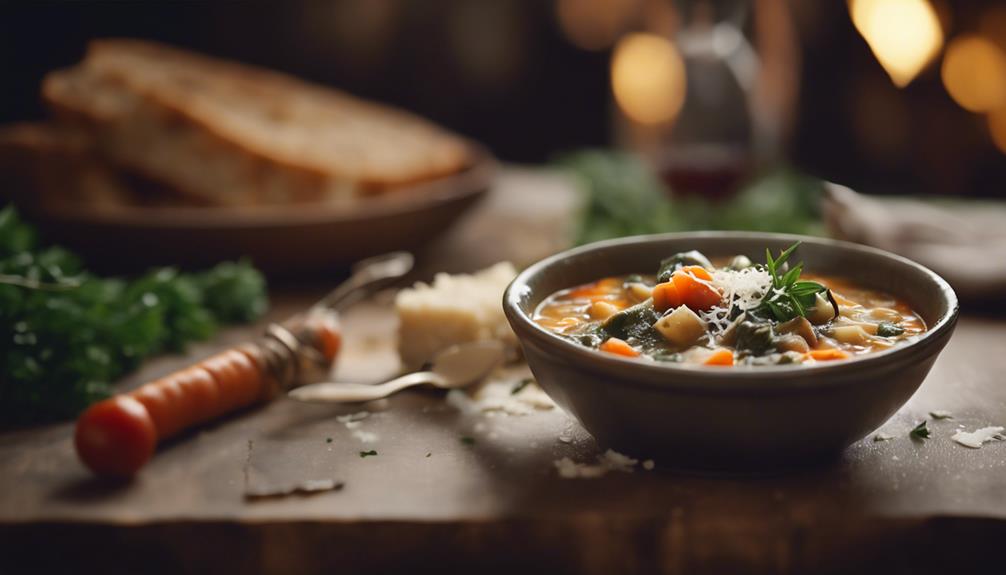
Italian soups and stews offer a hearty and flavorful twist to traditional Italian cuisine, perfect for warming up on chilly evenings. When you think of comfort food, these rustic dishes are sure to come to mind.
Here are three examples that will make your taste buds dance:
- Pasta Fazool: This classic Italian soup combines hearty beans, pasta, and savory pancetta in a rich tomato broth. Each spoonful brings a burst of flavors that will leave you craving more.
- Tortellini Soup: Delicate tortellini pasta parcels swim in a savory broth, showcasing the subtle yet delicious flavors of Italian cooking. It's a comforting dish that's both light and satisfying.
- Pork Agrodolce: This traditional Italian stew strikes the perfect balance between sweet and sour, making it a go-to choice for cold weather meals. The tender pork, paired with aromatic spices, creates a dish that's as comforting as it's delicious.
Italian Regional Specialties
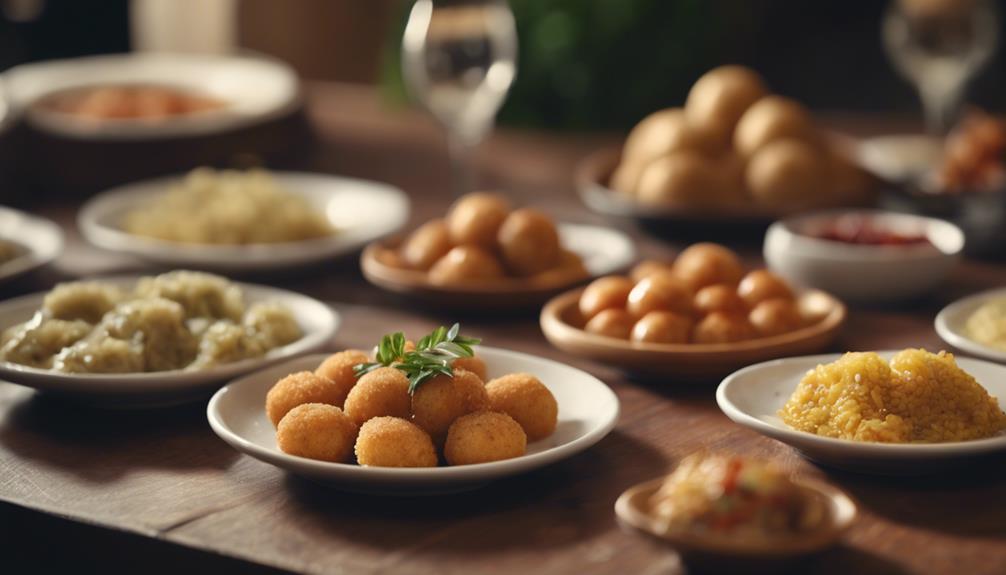
When it comes to Italian regional specialties, get ready to begin on a culinary journey filled with pasta varieties that vary from region to region.
From the hearty comfort of Tuscan pappa al pomodoro to the delicate flavors of Venetian fegato alla veneziana, each dish tells a story of tradition and innovation.
Regional Pasta Varieties
Explore the diverse range of regional pasta specialties found throughout Italy, showcasing unique flavors and culinary traditions.
- Sicily's Pasta alla Norma:
Picture a delightful blend of pasta, tender eggplant, and vibrant tomato sauce coming together in perfect harmony, creating a dish that's both comforting and full of Mediterranean flavors.
- Tuscany's Pici:
Imagine thick, hand-rolled pasta strands gracefully coated in a rich ragu or simply dressed with garlic-infused olive oil, offering a rustic and satisfying dining experience straight from the heart of Tuscany.
- Campania's Spaghetti alle Vongole:
Envision a plate of al dente spaghetti tangled with succulent clams, aromatic garlic, a splash of white wine, and a sprinkle of fresh parsley, transporting your taste buds to the sunny shores of the Amalfi Coast with each delicious bite.
From the hearty Tortellini in Brodo of Emilia-Romagna to the charming Orecchiette of Puglia, Italy's regional pasta varieties promise a culinary journey filled with tradition, innovation, and above all, a celebration of the country's rich gastronomic heritage.
Unique Pizza Styles
Exploring the culinary diversity of Italy, discover the unique pizza styles that showcase regional specialties and local flavors.
Italian regional specialties offer a delightful array of pizza styles, each representing different regions with their distinct ingredients and tastes.
The Margherita pizza, with its classic combination of tomatoes, mozzarella, and basil, not only delights the palate but also pays homage to the colors of the Italian flag.
If you're a fan of variety, the Quattro Stagioni pizza is a must-try, as it cleverly divides the pie into four sections, each symbolizing a different season with its unique toppings.
For those craving a bit of heat, the Diavola pizza is the perfect choice, featuring a spicy kick typically derived from fiery salami or pepperoni.
These regional pizza styles, like the Margherita, Quattro Stagioni, and Diavola, allow you to venture on a flavorful journey through Italy without leaving your dining table.
Traditional Desserts Selection
Indulge in a delightful array of traditional Italian desserts that showcase regional specialties and flavors unique to various parts of Italy.
- Tiramisu: Originating from the Veneto region, this delectable coffee-flavored dessert layers delicate ladyfingers with a creamy mixture of mascarpone cheese, eggs, sugar, and a hint of cocoa. It's a perfect balance of sweetness and bitterness that melts in your mouth.
- Panna Cotta: This silky-smooth dessert hails from Northern Italy and translates to 'cooked cream.' It's a simple yet elegant treat made by simmering cream, sugar, and gelatin, then chilling until set. Panna Cotta is often served with a luscious fruit compote or a drizzle of rich caramel sauce.
- Cannoli Siciliani: Straight from the sunny island of Sicily, these iconic tube-shaped pastries are filled with a sweet ricotta cheese mixture and often studded with pistachios or candied fruit. The crunchy shell contrasts perfectly with the creamy, decadent filling, making each bite a true delight.
These traditional Italian desserts offer a taste of Italy's rich culinary heritage and are sure to satisfy your sweet tooth with their unique regional flavors.
Modern Italian Fusion Creations

Modern Italian fusion creations cleverly blend traditional Italian flavors with innovative techniques and ingredients from other cuisines. These dishes take Italian cuisine to new heights by incorporating global influences to create exciting culinary experiences.
Chefs in this domain are like culinary artists, using a canvas of flavors, textures, and presentation to craft visually stunning and delicious dishes that push the boundaries of traditional Italian fare. Imagine classic Italian recipes with a twist, where ingredients like miso, sriracha, truffle oil, and exotic spices are seamlessly integrated to add unexpected and delightful elements.
The world of modern Italian fusion reflects a dynamic culinary landscape that embraces creativity, diversity, and the evolution of traditional recipes. It's a playground for chefs to experiment, innovate, and surprise diners with dishes that marry the best of Italian cuisine with techniques and ingredients from around the globe.
Frequently Asked Questions
What Are the Top 10 Italian Dishes?
When listing the top 10 Italian dishes, consider classics like Spaghetti Carbonara, Lasagna, and Risotto Milanese. Don't forget favorites such as Chicken Parmesan and Osso Buco. Indulge in comfort foods like Homemade Lasagna and Minestrone Soup, finishing with Tiramisu for dessert.
What Are 5 Traditional Italian Dishes?
Imagine the allure of traditional Italian cuisine. Indulge in Spaghetti Carbonara with its creamy pancetta sauce or savor Lasagna Bolognese's layers of pasta and meat. Osso Buco, Risotto Milanese, and Eggplant Parmesan also await your taste buds.
What Is Italy's Most Popular Dishes?
When in Italy, indulge in popular dishes like spaghetti carbonara, fettuccine alfredo, and lasagna bolognese. Enjoy traditional favorites such as osso buco and saltimbocca alla romana. Seafood lovers savor linguine alle vongole and risotto ai frutti di mare.
What Should I Serve for an Italian Dinner?
For an Italian dinner, serve up a feast with classics like Pasta Carbonara, Lasagna, and Chicken Parmesan. Don't forget to add a touch of sweetness with Tiramisu for a delightful ending to your meal.
What are some Traditional Italian Dishes to Serve?
When hosting a dinner, it’s important to consider traditional Italian dining customs. Some classic Italian dishes to serve include spaghetti aglio e olio, risotto alla milanese, and osso buco. Make sure to serve multiple courses and offer wine pairings to enhance the dining experience.
Conclusion
To sum it up, delving into the world of Italian cuisine is like indulging in a culinary masterpiece – rich, flavorful, and unforgettable.
So, why not grab a fork and dig into the deliciousness that Italy has to offer?
From classic pasta dishes to modern fusion creations, there's something for everyone to savor.
Buon appetito!
